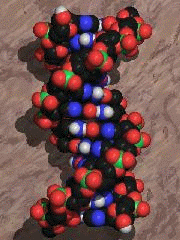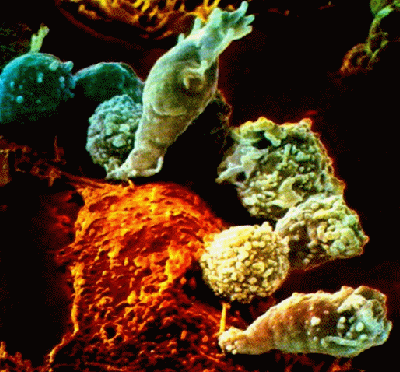Michael Fumento
Factual · Powerful · Original · Iconoclastic
The Hyped Genome Project
January 01, 2001 · Michael Fumento · MediaIt’s deja-hype all over again.
The June 2000 announcement of the sequencing of the human genome was practically treated as the biggest science news story since the lunar landing.
Celebratory press conferences were held on both sides of the Atlantic, with President Clinton and British Prime Minister Tony Blair congratulating the two rival sequencing groups, the for-profit Celera Genomics of Rockville, Maryland and the publicly-funded International Human Genome Sequencing Consortium.

Perhaps they’ll find the gene predisposing people to B.S.
Now that both Science and Nature magazines have hit the stands with the same cover subject, one journal publishing Celera’s sequence and the other that of the consortium, "The Eagle Has Landed" again.
The metaphors are flying fast and furious. "Reading the Book of Life," proclaims a headline in the New York Times. "Recipe of Life Revealed," declared the Dallas Morning News. "Road Map to the Core of Mankind," exclaimed the Houston Chronicle.
How exciting! How riveting! How irrelevant!
Never mind the repeated references to the "completed" project that even the sequencers say won’t be complete for years; even the ubiquitous "rough draft" analogy is worthless.
Could a sketch of a house with only 200 lines be considered a "rough draft?" Perhaps. But how useful is a rough draft of a house if you don’t even know its size, the number of rooms, or what type rooms they are?
Celera estimates we have about 39,000 genes, but adds that evidence for the existence of 12,000 of these genes is weak. The public consortium’s initial set contains about 32,000 genes, comprising 15,000 that are known and 17,000 predictions. Analyses of other groups put the figure as high as 100,000 or more.
Celera and the public consortium also admit they don’t know the purpose of over 40 percent of the genes — assuming they knew how many there were.
Indeed, even referring to the "human genome" is misleading. Celera and the consortium have created "consensus maps" or "Joe Average genomes." Those maps are slightly different from yours and mine.
This point is far from splitting hairs — or DNA — because when it comes to fixing our bodies or finding which medicine is best for which person, arguably the most important aspect of our genomes is not the 99.9 percent of the genes we share but the small portion that’s different.
Perhaps the best analogy for what the sequencers have done is to say they spelled out an alphabet of about three billion letters. These are the "base pairs" of DNA. If you think you can become a Russian interpreter because you know all the letters of the Cyrillic alphabet, you’ll soon find you’re mistaken.
Last year, Tim Hubbard, director of human genome sequencing at the Sanger Center in Cambridge, England declared that Celera CEO J. Craig Venter’s announcement that he’d sequenced the genome was hype.
"It doesn’t mean anything," Hubbard told the Independent of London. "He’s got fragments of DNA sequences but he has not yet assembled them into anything meaningful." Ironically, Hubbard’s group is part of the consortium that now mimics Venter’s claim.

If you already have cancer, the Celera and Human Genome Consortium data will do you no good.
Venter’s PR stunt hoisted his company’s stock last year, and his publication this year in Science boosted it almost 15 percent in one day. The consortium, with its 10-year head start, huge taxpayer-funded international team, and appropriated budget of $3 billion, apparently felt obliged to save face.
But the real heroes of the biotechnology revolution are the researchers and companies who realize you don’t need a map of the world to go from New York to Boston. They’ve spent years seeking out individual genes and their proteins and are already applying them to medicine.
This includes:
- What may be the greatest cancer breakthrough in decades, a drug from Switzerland-based Novartis called Glivec. Taken as a pill, it’s shown incredible effectiveness against a form of adult leukemia and is now being evaluated for use against a range of other cancers as well.
- A recently FDA-approved box the size of a desktop computer called "FastPack," from the tiny San Diego company of Qualigen. It provides cheap 15-minute tests for prostate cancer markers in the blood, and will soon be modified for detection of many other diseases as well.
- Companies like Vertex Pharmaceuticals and Millennium Pharmaceuticals, both of Cambridge, Massachusetts, that have tossed out the old paradigm of "Let’s look at one disease and try to find a therapy." Instead, they’re doing massive parallel screening and even designing of many compounds against many disease targets. This allows them to discover therapies by the batch, and to find that sometimes a single drug may be effective against as diverse as a range of illnesses as cancer, psoriasis, and organ rejection.
According to the Biotechnology Industry Organization, there are now over 110 FDA-approved biotechnology drugs, vaccines and new indications for existing medicines, with almost a third of those approved just last year. Another 350 biotech medicines targeting more than 200 diseases are now in late-stage development.
At least one prominent critic (and competitor) of Celera, CEO William Haseltine of Rockville-Based Human Genome Sciences, has called Celera’s sequence "a worthless database." That’s going too far.
Already, the sequencing has led to the discovery of some heavily-hunted genes involved in disease. Practical applications will follow.
But polls show that many Americans aren’t sure whether they should welcome biotechnology or dread it. Focusing attention on how it’s already helping us seems more productive than inundating people with forests of newsprint about speculative and exaggerated ventures.
